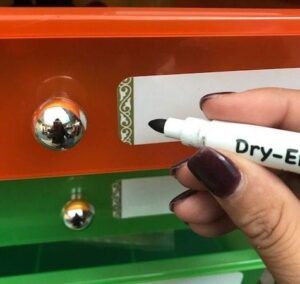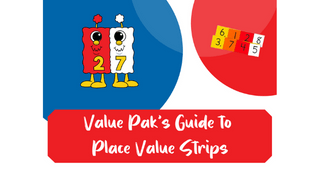Math involves a lot of preparation, especially when you’re using manipulatives. We want to put the C back in CPA (concrete, pictorial, abstract). Of course, C stands for concrete, but it also stands for careful planning!

You don’t want to just have the Math Salad Bar in the classroom and just wing it. You want it to be carefully planned and organized, you want to know what each of the manipulatives is used for.
Recently, a few of the schools we work with for our Math Initiative were able to get grants to purchase the supplies needed for assembling their very own Math Salad Bars. The Math Salad bar is a big component of our initiative because it provides a way to effectively store and distribute the manipulatives students need during their math instruction. (Not sure what a Math Salad Bar is? Check out this blog post!)
Often, teachers find the task of setting up a Math Salad Bar to be overwhelming and tedious because there are so many individual items that need to be labelled and given a home so that everything goes back together into the right drawers as neatly and easily as possible after students are done using the items. We got to spend a day at the school helping them put together materials to get their Math Salad Bars ready to go!
Sometimes as teachers, we depend only on the drawings and the abstract during our math instruction, and we hope that students just “get it.” If you just draw something or think about it abstractly, the likelihood of remembering is not as good as if you had been able to physically interact with it. If a child has an experience with using manipulatives in an inquiry-based way (not just “do this, do this, do this” but “show me how this would work with these manipulatives”), it provides an imprint in the brain that creates a memory for that child to recall next time they are doing that particular activity.
But, even once we get all the materials purchased, there are usually still a lot of questions about how to actually physically assemble the Math Salad Bar, such as: How many of each set do I need for this? How do I need this manipulative in the drawer so students can use it best?
Let’s get started!

Step 1: Stick Dry Erase Labels on Math Salad Bar drawers.
Our Math Salad Bar comes with ten drawers on one side, five drawers on the other, and Avery Dry Erase labels to put on each
one. These are nice because you might change what is actually on the Salad Bar depending on what you need for that particular chapter or unit you’re working on. By writing clearly on the label, your students (and you!) can easily see what’s on the Math Salad Bar. If I wanted to swap out the 3D shapes for my fractions, I can just wipe off the label and write the new manipulative name on it, and students know exactly where things are supposed to go.
Step 2: Organize manipulatives into sets.
Place Value Discs
- Store Link: https://sis4teachers.org/shop/Place-Value-Whole-Number-Discs-1-1000-p91924234
- Recommended amount per set: 17 or 18 per value.
- Each set is suitable for: 1-4 students.
- Available as: 1 bag
- One bag will serve 2-8 students, depending on how the students are using the manipulatives.
The discs come in a bag of 35 of every value (1s, 10s, 100s, 1000s). One bag of discs could be split into two sets. One set would have 17 of each value, one would have 18 of each. This way still provides plenty of place value discs for students to use if they had a problem that needed to be renamed or if they needed to exchange a 10 for ten 1s. You could have as many as 20 of each value, but that really isn’t necessary. Some classrooms do 15 of each value, which also works fine if you can control the problems so students don’t ever need more than fifteen 1s or 10s, and so forth. The teachers in the pictures pulled 17 of each value out of their bags to create two sets. They turned over all the discs in a particular set and wrote the letter A on the back of each of the discs so students can easily identify which discs belonged to each set. Then, repeat with B, and so one, for the rest of the discs.
Place Value Strips
- Store link: https://sis4teachers.org/shop/Place-Value-4-Digit-Strips-Student-Size-p91408047
- Recommended amount per set: 15 per value
- Each set is suitable for: 1-4 students
- Available as: set of 30 or set of 10
- One set of 30 will serve 5-20 students, depending on how students are working (in groups, independently, etc.)
This is a big thing to tackle in the Math Salad Bar! My recommendation is to divide your place value strips into two sets, as you see pictured here. We took out two sets of 1, two sets of 10, two sets of 100, and two sets of 1000. Write A on the back of every place value strip to indicate that set belongs to A. Then they perforate the strips and put them in a rubber band. This allows for students to have two of every value. Once it’s perforated, you can divide it into sets of 15. In this case, kids could use the sets individually, but ultimately, the pack would be great for buddies. If more than one student will be using a set of manipulatives, Partner A would be in charge of the 1s and the 10s, and Partner B would be in charge of the 100s and 1000s.
The bag of place value strips would allow for 15 groups of two (which gives each group quite a few) or if you wanted to use it with four kids per group, you could split the set of 30 with another teacher. The set of 10 only gives you a set for five students, or up to twenty students if you’re doing four in a group.
Decimal Place Value Strips
- Store Link: https://sis4teachers.org/shop/Place-Value-Decimal-Strips-Student-Size-p91408048
- Recommended amount per set: 15 per value
- Each set is suitable for: 1-4 students
- Available as: set of 30 or set of 10
The place value decimal strips ware similar to the regular place value strips. They come in a pack of 30 and of 10. Our suggestion is that teachers take out two sets of .10s, two sets of .100, and two sets of .1000, label them all with an A, perforate them, and rubber band them together. These are more appropriately used in 4th and 5th grade.
Deck o Dots
- Store Link: https://sis4teachers.org/shop/Deck-o-Dots-p91343303
- Recommended amount per set: 1 deck (1 red deck, 1 yellow deck, 1 green deck)
- Available individually, in a set of 5 decks, or a set of 15 decks
When preparing Deck o Dots for your Math Salad Bar, you want to make sure that the decks are separated into colors (red, yellow, and green), and in addition, you want to label each of those three decks with the same letter because you might want the decks to go back together at some point. Then, you can put each color deck into a separate bag or soap container.
Step 3: Organize the rest of the manipulatives into drawers.
You want the manipulatives to be organized so students access them easily. If you have counting buddies, store those in a drawer like you see pictured here. In another drawer, we have centimeter cubes and kids can use one of the bowls at the top of the Salad Bar to scoop those up for transportation.
Game Boards
The Math Salad Bar also comes with clear plastic sheet protectors to hold your game boards. If you’re playing Bump, you can just make 3-5 copies and put them in the clear plastic sleeves to save you the time it takes to laminate and cut them out.
Other Considerations
Creating a flipbook, a math manipulative guide of sorts, is an easy way to remember all the uses for each of the manipulatives in the Salad Bar. Our math books aren’t always going to say, “You’re doing partial sums – it’s really great to do that with place value strips first to give students a conceptual hands-on experience.” Sometimes, we just need a reminder of all the concepts that manipulatives can be used for.
In the Math Initiative, we look for instructional strategies that can be applied to our math instruction within whatever district-purchased textbook is used because that district-purchased textbook isn’t the curriculum. The standards are your curriculum and that particular textbook is a resource. We still follow the objectives laid out in the textbook and we still keep the pacing of the district, but when a concept is being taught and the child isn’t getting it, we want to know what strategies we can use to support students in their understanding.
Be sure to think about the manipulatives you have available on the Math Salad Bar at any given time. The materials that are on the Math Salad Bar should be materials you are actually using during your unit of study. If you’re doing fractions, you’ll want your fraction tiles, patty paper, and my pattern blocks. If you’re done with fractions, you’ll remove those things and add in the things for the next unit. Research supports the idea of making manipulatives available to students three weeks prior to when you actually want to start using them. Allowing time for purposeful tool exploration in the weeks preceding a unit will provide students with experience using the tools so they will be more effective with them when it comes time to use them mathematically. So think ahead and put out some things you’ll be using in upcoming weeks!
























